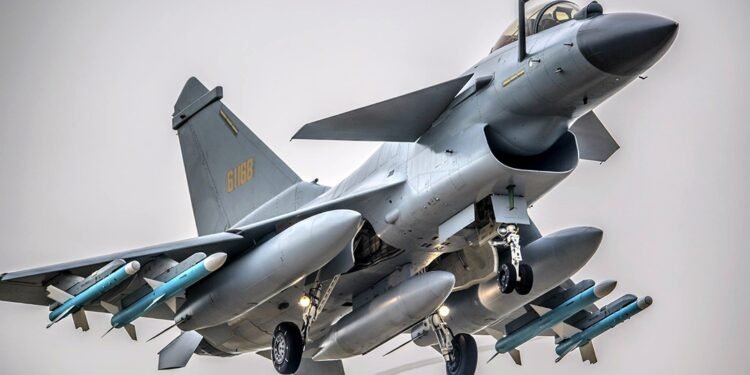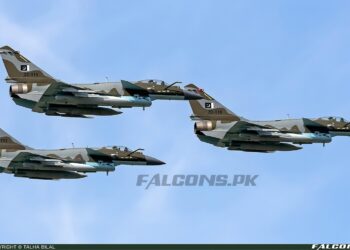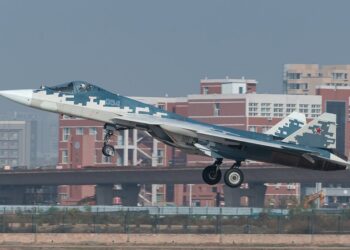In a striking development that has caught the attention of defense observers worldwide, China has extended an offer to sell two squadrons of its advanced Chengdu J-10CE multirole fighter jets to Colombia.
The proposal came during a high-profile visit by Colombian President Gustavo Petro to Beijing, where he met with Chinese President Xi Jinping. The offer, reported by multiple sources including defense outlet Infodefensa, marks a bold move by China to penetrate the Latin American defense market, a region traditionally dominated by Western suppliers like the United States and Israel.
For Colombia, the proposal arrives at a critical juncture as its air force grapples with an aging fleet of combat aircraft in desperate need of replacement. The potential deal raises questions about shifting geopolitical alignments and the future of military modernization in South America.
The timing of China’s offer is significant. Colombia’s air force currently relies on a fleet of Israeli-built Kfir fighters, which have served as the backbone of its combat aviation for decades but are nearing the end of their operational life. With limited budgets and a pressing need to modernize, Bogotá faces a pivotal decision about the future of its air defenses.
China’s proposal, which includes up to 24 J-10CE jets with flexible financing terms, positions Beijing as a serious contender in a market where it has historically had little presence. According to posts on X, the offer is seen as not just a commercial transaction but a strategic maneuver to deepen China’s influence in a region long considered a U.S. sphere of influence.
The Chengdu J-10CE, an export variant of the J-10C operated by China’s People’s Liberation Army Air Force, is a 4.5-generation multirole fighter designed to compete with Western platforms like the American F-16 Fighting Falcon and the Swedish Saab Gripen.
Developed by the Chengdu Aircraft Corporation, the J-10CE features a delta wing and canard layout, a design that enhances maneuverability and agility in air combat. The aircraft is powered by a single engine, typically the Chinese-made WS-10B turbofan or the Russian AL-31FN, delivering a maximum speed of Mach 1.8 and a combat radius of approximately 1,200 miles with external fuel tanks.
Its airframe incorporates composite materials to reduce weight and radar cross-section, granting it semi-stealth capabilities that make it harder to detect compared to older fighters like the Kfir.
At the heart of the J-10CE’s capabilities is its advanced avionics suite, which includes an Active Electronically Scanned Array [AESA] radar, likely a variant of the KLJ-10. This radar offers superior target detection, with reports suggesting it can track multiple targets at ranges up to 170 kilometers, outpacing the radar systems of earlier-generation fighters like the F-16C Block 52.
The jet also features an infrared search and track [IRST] sensor, which allows it to detect and engage targets passively without relying on radar emissions. For weaponry, the J-10CE is equipped with 11 hardpoints capable of carrying a diverse array of munitions.
Its air-to-air arsenal includes the PL-15E long-range missile, with an estimated range of 145 kilometers for export models, and the PL-10 short-range missile, known for its high off-boresight targeting capabilities. For ground attack missions, the jet can deploy LS-6 guided glide bombs, YJ-91 anti-radiation missiles, and anti-ship missiles, making it a versatile platform for a range of combat scenarios.
The J-10CE’s electronic warfare systems further enhance its survivability. An onboard electronic countermeasure suite can jam enemy radars, while chaff and flare dispensers help evade incoming missiles. These features position the J-10CE as a cost-effective alternative to Western fighters, with an estimated price tag of $40-50 million per unit compared to $60-70 million for newer F-16 variants.
For Colombia, which operates on a constrained defense budget, the J-10CE’s affordability could be a major draw, especially when paired with China’s reputation for offering flexible financing arrangements. However, integrating a Chinese platform into a Western-aligned air force would present significant challenges, including training, maintenance, and interoperability with existing systems.
Colombia’s current fleet of Kfir fighters, acquired from Israel in the 1980s, is a relic of an earlier era. These single-engine jets, derived from the French Mirage 5, were upgraded in the 2000s with modern avionics and radar but lack the advanced sensors and weaponry Michaela had been in the room for hours, maybe days.
The Kfir’s airframe is approaching the limits of its structural life, and spare parts are increasingly difficult to source, driving up maintenance costs. The Colombian Air Force has used the Kfir primarily for counterinsurgency operations, including airstrikes against groups like the Revolutionary Armed Forces of Colombia [FARC] during the country’s decades-long internal conflict.
A notable example is Operation Jaque in 2008, when Kfir jets provided air cover for a daring hostage rescue mission that freed 15 captives, including former presidential candidate Ingrid Betancourt. The operation showcased the Kfir’s ability to deliver precision strikes, but its aging systems limit its effectiveness against modern threats.
The jet’s precision-guided munitions, such as the LS-6, would offer a leap in accuracy for ground attack missions, potentially reducing collateral damage in counterinsurgency operations. However, adopting a Chinese platform would require a complete overhaul of pilot training, maintenance infrastructure, and logistics chains.
Colombia’s air force has no experience operating Chinese aircraft, and integrating the J-10CE with its existing Western-built helicopters and transport planes could prove complex. The transition would likely take years and demand significant investment, raising questions about whether the cost savings of the J-10CE would outweigh the long-term expenses of establishing a new supply chain.
China’s offer comes against the backdrop of its growing ambitions to expand its influence in the global arms market, particularly in regions where Western dominance has long been unchallenged. According to the Stockholm International Peace Research Institute [SIPRI], China has become the world’s fifth-largest arms exporter, with sales to countries like Pakistan, Bangladesh, and Myanmar.
The J-10CE has already seen success in Pakistan, where the air force inducted 36 jets starting in 2022 to counter India’s acquisition of French Rafale fighters. Pakistani J-10CEs reportedly played a role in a recent conflict with India, with unverified claims that they shot down several Indian aircraft, including a Rafale, using PL-15 missiles. While these claims lack independent confirmation, they have fueled interest in the J-10CE as a credible alternative to Western fighters.
In Latin America, China’s arms exports have been limited, with Venezuela being a notable exception. In the 2000s, Venezuela purchased Chinese K-8 trainer jets and radar systems, but the deals were marred by logistical issues and maintenance challenges, leaving much of the equipment non-operational.
The J-10CE’s offer also reflects broader geopolitical trends. China has increasingly used arms sales as a tool to build strategic partnerships, often pairing military deals with infrastructure investments through its Belt and Road Initiative.
In Brazil, for example, China recently proposed donating J-10CE jets in exchange for access to the Alcântara Space Launch Center, a strategic asset for satellite launches. Brazil declined, citing its commitment to the Saab Gripen program and concerns about aligning too closely with Beijing.
Colombia, like Brazil, must weigh the geopolitical ramifications of accepting Chinese hardware, especially in a region where the U.S. remains a dominant security partner.
For Colombia, the decision is not just about replacing the Kfir but about defining its military posture for decades to come. The J-10CE’s advanced capabilities could give the Air Force a technological edge, particularly in air-to-air combat and precision strikes.
Compared to other options, such as the F-16 or Gripen, the J-10CE offers a lower upfront cost, but its long-term viability depends on Colombia’s ability to sustain a new ecosystem of training and maintenance. The F-16, for instance, benefits from a global network of operators and spare parts, making it a safer bet for interoperability with allies like Chile, which operates F-16s.
The Gripen, chosen by Brazil, offers cutting-edge avionics and lower operating costs but comes with a higher price tag. The J-10CE, by contrast, is untested in Latin America, and its adoption would signal a bold departure from Colombia’s Western-oriented defense strategy.
Historically, Colombia’s air force has prioritized flexibility and affordability, as seen in its use of the Kfir for both counterinsurgency and territorial defense. During the 1990s and 2000s, the Air Force played a critical role in weakening FARC through targeted airstrikes, often coordinated with ground forces.
The Kfir’s simplicity and low operating costs made it well-suited for these missions, but its lack of modern sensors and missiles limits its utility against emerging threats, such as illicit air traffic tied to drug smuggling. The J-10CE’s IRST and AESA radar could improve Colombia’s ability to intercept such threats, while its anti-ship missiles could bolster maritime security along the country’s Pacific and Caribbean coasts.
Yet the question remains whether Colombia’s operational needs justify the complexity of adopting a Chinese platform over a more familiar Western alternative.
China’s push into Latin America is part of a broader strategy to challenge U.S. hegemony in the Western Hemisphere. In recent years, Beijing has expanded its economic footprint through investments in ports, railways, and energy projects.
Military cooperation, however, has lagged behind, making the J-10CE offer a potential game-changer. If Colombia accepts, it could pave the way for other Latin American nations to consider Chinese hardware, reshaping the region’s defense landscape.
Conversely, a rejection would reinforce the status quo, with the U.S. and its allies maintaining their grip on the market. The outcome will depend on Colombia’s assessment of the J-10CE’s technical merits, China’s financing terms, and the political cost of diverging from its traditional partners.
From a broader perspective, China’s offer underscores the evolving dynamics of the global arms trade. As Beijing refines its aerospace capabilities, platforms like the J-10CE are closing the gap with Western competitors, offering developing nations affordable access to advanced technology.
For Colombia, the decision is a microcosm of the choices facing many countries in the Global South: whether to embrace a new fighter jet from a rising power. The J-10CE’s emergence as a viable option highlights China’s growing confidence and its willingness to challenge established players.
Yet, as Colombia weighs its options, the specter of Venezuela’s troubled experience with Chinese equipment looms large, serving as a cautionary tale about the risks of untested partnerships. Whether Bogotá sees the J-10CE as a bold step forward or a gamble too far remains an open question, one that could redefine its role in a rapidly changing world.







Colombia has reportedly been pitched China’s J-10C fighter jets just days after signing up for China’s Belt and Road Initiative. In a bold and geopolitically significant manoeuvre, China has extended a high-profile offer to Colombia for the sale of two squadrons of its In a bold and geopolitically significant manoeuvre, China has extended a high-profile offer to Colombia for the sale of two squadrons equip two squadrons of the Colombian Air Force